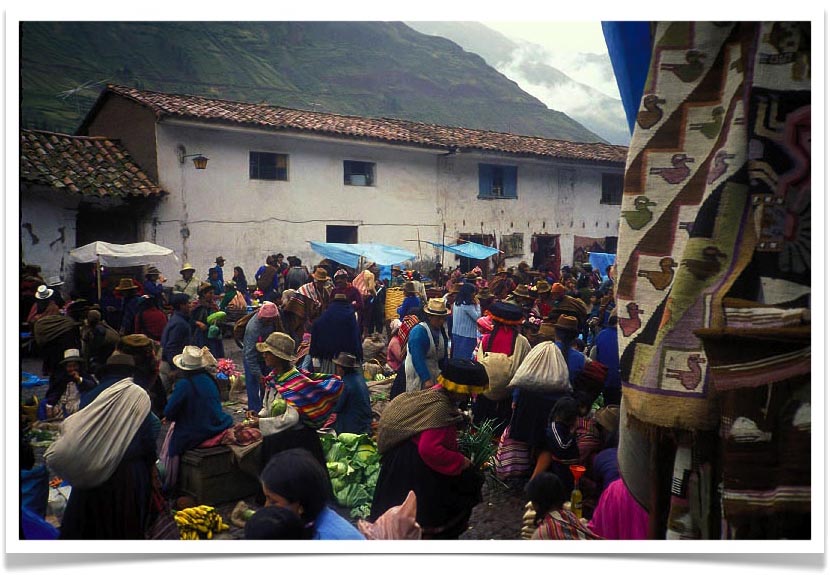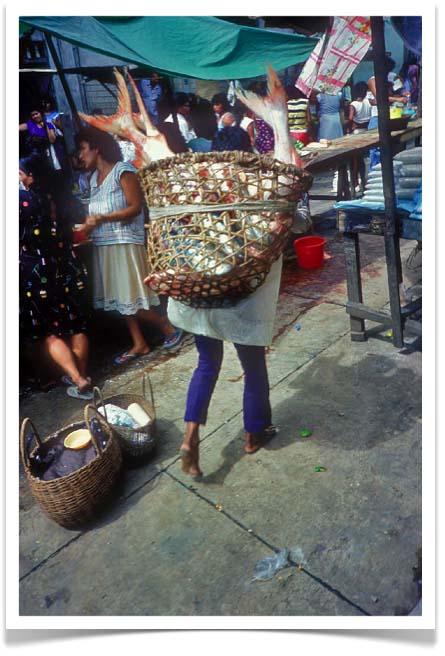Cusco Market
 Friday, November 28, 2008 at 8:46AM
Friday, November 28, 2008 at 8:46AM 
And while I am thinking about markets, this is what Saturday looks like in the main produce market of Cusco, Peru.
If you see books or music or tools on this site that you would like to buy through Amazon, click here and thus i have seen will get a small percentage of the purchase price of the item. Thank you.
The Elements of Typographic Style
Patagonia Synchilla Snap-T Pullover
Minding the Earth, Mending the Word: Zen and the Art of Planetary Crisis
North Face Base Camp Duffel (Medium)
 Friday, November 28, 2008 at 8:46AM
Friday, November 28, 2008 at 8:46AM 
And while I am thinking about markets, this is what Saturday looks like in the main produce market of Cusco, Peru.
 Wednesday, November 26, 2008 at 9:45AM
Wednesday, November 26, 2008 at 9:45AM 
The Belén market of Iquitos (see Real Big Fish) gets inundated every year during the floodpeak of the Amazon River. The residents of this part of the city have come up with several different strategies for dealing with the annual flooding. They build their houses on stilts (see Danau Sentarum), or on pontoons (floating logs, actually), or they build two storey houses and simply move upstairs during the flood. The last strategy requires shoveling out a lot of mud once the floodwaters recede. [NOTE: The image above was taken in the mid-1980's. Since then, the Amazon River has changed course and no longer flows right in front of Iquitos. The Belén market, however, still floods every year. Now the floodwaters come from the Itaya River.]
 Belén market,
Belén market,  Iquitos,
Iquitos,  Ucayali river in
Ucayali river in  Other |
Other |  Share Article |
Share Article |  Email Article |
Email Article |  Print Article
Print Article  Tuesday, November 25, 2008 at 9:33AM
Tuesday, November 25, 2008 at 9:33AM 
This fish seller was casually walking through the bustling Belén market in Iquitos, Peru. No one - except me - gave him a second glance.
 Monday, November 24, 2008 at 11:01AM
Monday, November 24, 2008 at 11:01AM Andrew Henderson, Dr. Ninh Khac Ban (see Weaving a Trivet), and I collect an interesting and unique species of rattan in Bach Ma National Park, Vietnam. Interesting because it is branched, unique because rattans don't normally do this. It turned out to be a new species to science.
 Bach Ma National Park,
Bach Ma National Park,  Calamus,
Calamus,  Vietnam in
Vietnam in  Science |
Science |  Share Article |
Share Article |  Email Article |
Email Article |  Print Article
Print Article  Saturday, November 22, 2008 at 10:12AM
Saturday, November 22, 2008 at 10:12AM 
Pak Afong (with the baseball cap) and Pak Po'on (with the towel), both Selako Dayaks from the village of Bagak Sawah in West Kalimantan, helped a lot with my research on illipe nuts at the Raya-Pasi Nature Reserve (see Illipe Nut III). Pak Afong was the official forest guard at Raya-Pasi, and he was the one who first told me about the annually fruiting illipe nut and helped me lay out and monitor my research plots. He was also the one who stopped me from stepping on the cobra (thx, Afong). Pak Po'on, an older gentleman who always went to the field in flip-flops, would help out when Pak Afong was not available. Po'on loved to talk and was an enthusiastic kretek smoker. The only thing that he would bring to the field was his towel and parang, so whenever it rained we would both hunker down under my poncho. Invariably, Pak Po'on would light up a kretek and start telling a story, usually about the old days during the Japanese occupation. The smoke under the poncho would get so thick that I couldn't see his face. It was a pleasure to work with both of these men. [NOTES: Pak Po'on's parang is stuck in the durian tree to the left of his head. The Indonesian word for tree is pohon.]
 Raya Pasi Nature Reserve,
Raya Pasi Nature Reserve,  West Kalimantan in
West Kalimantan in  Other |
Other |  Share Article |
Share Article |  Email Article |
Email Article |  Print Article
Print Article  Wednesday, November 19, 2008 at 9:23AM
Wednesday, November 19, 2008 at 9:23AM 
A lot of rattan harvested in the Danau Sentarum National Park (see Danau Sentarum) is used for lashing logs together to float them downriver to the sawmill. Several "floater" logs are lashed to "sinker" logs until a bam of 20 logs is formed. Twenty bam are then lashed together to make a raft of 400 logs. I was always curious about how much rattan this took, so the next time I saw a log raft floating through Danau Sentarum on its way to the Kapuas River, I motored over, hopped on, and did some counting. The construction of one bam requires about 150 rattan canes; an entire raft needs 3000 canes. Given that each cane is 6 meters long, every raft uses almost 18 kilometers of rattan. This cordage is discarded once the logs arrive to Pontianak. [NOTE: The image above shows a mega-raft of 800 logs, i.e. two rafts lashed together].
 Tuesday, November 18, 2008 at 10:13AM
Tuesday, November 18, 2008 at 10:13AM 
A Biltmore stick is a simple, inexpensive, and very useful tool for measuring tree heights and diameters. It does the job of a diameter tape and clinometer, at a fraction of the cost, and it can also be used to fight off snakes or clear brush during inventory operations. To function properly, the Biltmore Stick must be custom fitted to the user by first measuring his/her arm length. Based on this measurement, the appropriate height and diameter scales are inscribed on the stick. This is what is being done in the picture. The Biltmore sticks are being made by the participants in a workshop on "Sustainable Management of Oaxaca's Dry Forests" that Silvia Purata (see Alebrijes) and I gave in 2004.
Instructions for making your own Biltmore stick can be found here.
 Biltmore sticks,
Biltmore sticks,  dendrometers,
dendrometers,  forest inventory in
forest inventory in  Science |
Science |  Share Article |
Share Article |  Email Article |
Email Article |  Print Article
Print Article  Monday, November 17, 2008 at 9:43AM
Monday, November 17, 2008 at 9:43AM 
Parkia speciosa is a tall, bat-pollinated tree from the Asian tropics. The seeds of this species, know locally as petai, are combined with chili paste, garlic, and dried shrimp to make a variety of tasty sauces and curries. The downside of eating petai is that it changes the color of your urine to dark brown and makes it smell really horrible for several days. This can be a bit shocking if you are not expecting it. The English name for Parkia speciosa, quite approriately, is stink bean. [NOTE: The Parkia seeds shown above were photographed prior to purchase in Pontianak, West Kalimantan.]
 Friday, November 14, 2008 at 8:57AM
Friday, November 14, 2008 at 8:57AM 
The potent, milky-white beverage produced by fermenting cassava (Manihot esculenta) is called masato in the Peruvian Amazon. The brew is also known (to non-Amazonians) as "spit beer" because of the way that it is prepared. To stimulate the fermentation process, the cooked cassava tubers are first chewed and then spat out into a large pot. Apparently, the enzymes and bacteria in saliva give the beverage its characteristic taste. New (young) masato tastes a bit like yogurt; older masato is really, really alcoholic and strong. You are always offered a glass of masato the first time you visit a village. [NOTE: The image above, scanned from a print, was taken along the Rio Ucayali. I can't remember the name of either the village or the lady. Must have been good masato].
 Thursday, November 13, 2008 at 8:54AM
Thursday, November 13, 2008 at 8:54AM During a rattan survey of Bach Ma National Park in Vietnam, our field assistant gave us a quick lesson in weaving useful household items out of rattan. He made the whole trivet out of one rattan cane. And he took it home after we finished for the day. [NOTE: The other man in the clip is Dr. Ninh Khac Ban, a rattan specialist from the Institute of Ecology and Biological Resources in Hanoi.]
 Bach Ma National Park,
Bach Ma National Park,  Rattan,
Rattan,  Vietnam in
Vietnam in  Other |
Other |  Share Article |
Share Article |  Email Article |
Email Article |  Print Article
Print Article